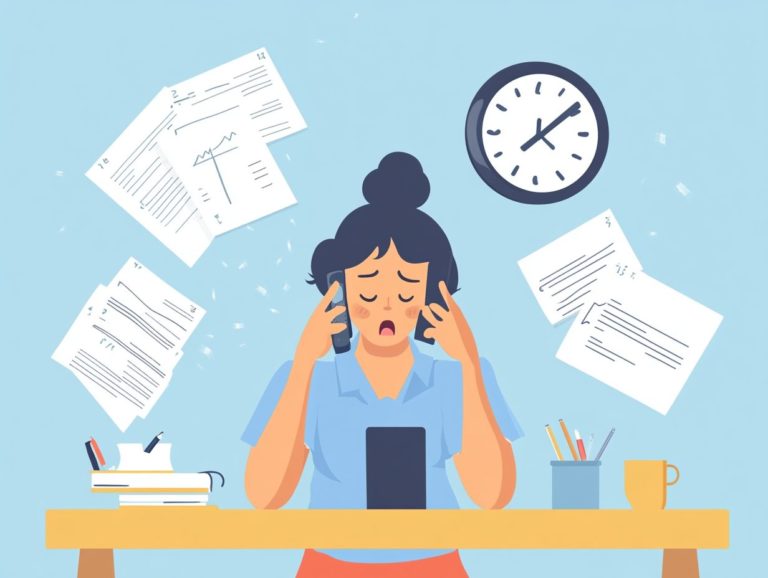How to Handle Multiple Vehicle Claims
Navigating the aftermath of a multi-vehicle accident can feel like traversing a labyrinth, especially when handling insurance claims.
This article simplifies the complexities of these claims, guiding you through essential definitions and outlining critical steps to take immediately following an accident. It delves into how insurance companies process these claims, offers negotiation strategies for engaging with other drivers, and highlights when it may be prudent to seek legal assistance.
By grasping these elements, you empower yourself to secure the compensation you deserve, alleviating some of the stress that naturally accompanies such situations.
Contents
- Key Takeaways:
- Understanding Multi-Vehicle Claims
- Steps to Take After an Accident
- Handling Multiple Vehicle Claims with Insurance Companies
- Negotiating with Other Drivers and Insurance Companies
- Legal Considerations for Multiple Vehicle Claims
- Frequently Asked Questions
- What is a multiple vehicle claim?
- How do I handle a multiple vehicle claim?
- Do I need to file separate claims for each vehicle?
- Will my insurance premium increase if I file a multiple vehicle claim?
- Do I need to hire an attorney for a multiple vehicle claim?
- How long does it take to process a multiple vehicle claim?
Key Takeaways:
- Be prepared for any potential accidents by understanding what multi-vehicle claims are and the types of claims that fall under this category.
- After an accident, prioritize safety and document everything carefully to ensure a smooth claims process.
- When dealing with multiple vehicle claims, effective negotiation skills and knowledge of insurance processes can help you receive fair compensation.
Understanding Multi-Vehicle Claims
Understanding multi-vehicle claims is crucial for navigating the complexities of car accidents, especially in busy areas like Los Angeles, where freeways often teem with traffic and risks.
These claims can involve several vehicles, adding complexity due to the potential for multiple drivers negligence, which means failing to take reasonable care. You should consider the intricate relationships between insurance companies, accident liability, and legal responsibilities.
As a result, injured parties often face a challenging claims process that requires a solid grasp of personal injury laws and an understanding of how negligence influences their cases.
Definition and Types of Multi-Vehicle Claims
Multi-vehicle claims involve insurance claims stemming from accidents that include two or more vehicles. These situations often unfold with intricate dynamics at the accident scene, leading to varying degrees of liability and injuries faced by drivers and passengers.
These claims can manifest in numerous ways. Take rear-end collisions, for example, where one vehicle strikes another from behind often due to sudden stops or momentary distractions. Then there are intersection accidents, which typically arise when vehicles collide while crossing paths; confusion over traffic signals or stop signs can contribute to these mishaps. Chain-reaction crashes frequently occur in heavy traffic where one collision triggers subsequent impacts involving multiple vehicles.
Adverse weather conditions, like rain or ice, significantly influence these incidents. Driver behavior also plays a crucial role; both aggressive and inattentive driving can dramatically increase the likelihood of accidents. Understanding these intricacies allows you to navigate the complexities associated with filing claims more effectively.
Steps to Take After an Accident
After a car accident, particularly in a multi-vehicle situation, it s essential to prioritize immediate safety and documentation. This approach not only safeguards your rights but also streamlines the claims process.
Start by checking for any injuries among everyone involved, then promptly call the appropriate authorities. Don’t forget to gather crucial evidence at the scene, all while keeping in mind your financial responsibilities under your insurance policy.
Take these steps seriously. By being prepared and informed, you can navigate the aftermath of a multi-vehicle accident more effectively and secure the support you need.
Immediate Actions to Ensure Safety and Documentation
After an accident, your immediate actions should center on safety. Make sure everyone involved is unharmed.
Documenting the situation thoroughly is also essential to support any future insurance claims.
First and foremost, if it s safe to do so, move the vehicles to a secure location to avoid any further mishaps. Once you ve ensured everyone s safety, it s vital to check for injuries among all parties.
Some may require urgent medical attention.
Next, effective documentation becomes crucial. Taking clear photographs of the scene, vehicle damage, and any pertinent road conditions will help substantiate your claims.
Gathering contact information from witnesses is also important; it can make a huge difference in your case.
These steps not only strengthen the claims process but can also impact potential settlement amounts, ensuring that you receive fair compensation for any damages incurred.
Handling Multiple Vehicle Claims with Insurance Companies
Managing multiple vehicle claims with insurance companies can be quite intricate. You’ll find yourself navigating the claims process after an accident, determining accident liability, and tackling issues like comparative negligence.
Each of these factors can significantly influence the outcome of your claims process and the settlement funds you ultimately receive.
How Insurance Companies Process Claims
Insurance companies handle claims with a keen eye for detail, meticulously evaluating the circumstances surrounding an accident.
This often involves gathering evidence and may include enlisting accident reconstruction experts to piece together the facts.
The claims process kicks off with insurance adjusters collecting a variety of information, including police reports, witness statements, and photographs from the scene.
When discrepancies arise in the accounts of the incident, accident reconstruction becomes vital in clarifying the sequence of events.
As a policyholder, your role is pivotal in this process. By providing all necessary documentation like medical records and repair estimates you help to streamline the evaluation.
Settlement assessments hinge on factors such as the severity of injuries, extent of vehicle damage, and overall liability. Accurate reporting is crucial for a just outcome.
Negotiating with Other Drivers and Insurance Companies
Negotiating with other drivers and insurance companies is an essential aspect of navigating the claims process after a multi-vehicle accident.
Grasping your financial responsibilities and the likelihood of claim disputes can significantly influence the settlement amounts you ultimately secure.
Tips for Successful Negotiation
Successful negotiation with insurance companies and other drivers after a multiple vehicle accident relies on your preparation and a clear understanding of accident liability.
Your ability to effectively articulate your position regarding settlement funds and any claim disputes is also crucial.
To bolster your negotiating power, gather all relevant documentation, including police reports, medical records, and repair estimates.
This thorough collection of evidence not only strengthens your claims but also showcases your commitment to accuracy and transparency.
Equally vital are your communication skills; expressing your thoughts clearly and confidently can significantly influence the negotiation process.
Having a solid grasp of the insurance landscape, including common settlement ranges for similar accidents, gives you the power to engage in discussions with realistic expectations.
Being well-informed can lead to favorable outcomes, ensuring you receive the compensation you rightfully deserve.
Legal Considerations for Multiple Vehicle Claims
Navigating the legal landscape of multiple vehicle claims requires a firm grasp of the details of personal injury law.
It also involves an appreciation for the nuances of comparative negligence.
Knowing when to enlist the expertise of a personal injury attorney is essential.
This approach clarifies liability issues and optimizes the compensation you can receive for any injuries sustained.
Take the next step: consult a personal injury attorney today to protect your rights and maximize your compensation.
When to Seek Legal Assistance
Knowing when to seek legal assistance after a multiple vehicle accident is vital for protecting your rights. It is especially important as you handle the complicated claims process, liability issues, and potential disputes with insurance companies over financial responsibility.
When significant injuries occur or conflicting accounts of the incident arise, you might feel overwhelmed and unsure about your next steps. Complications often surface while dealing with insurance claims, making it challenging to secure fair compensation for damages and medical expenses.
Enlisting a personal injury attorney can be invaluable. These professionals become your allies, guiding you through the legal intricacies, advocating for your rights, and ensuring you have the support necessary to navigate the often daunting journey toward recovery and compensation.
Understanding Liability and Compensation
Understanding liability is crucial for determining compensation after a multiple vehicle accident. It directly influences the comparative negligence assessment and ultimately affects the settlement amounts that injured parties can expect from their insurance policies.
In California, the idea of shared fault can add layers of complexity, as multiple parties might share responsibility for the accident, resulting in varying degrees of liability. For example, if one party is determined to be 30% at fault while another is 70%, their compensation would be adjusted accordingly, reflecting their respective percentages of responsibility.
This comparative negligence system means that even if you’re partly at fault, you could still recover damages, although this amount would be reduced based on your share of responsibility. It’s essential to understand your insurance policy limits, as these limits directly influence the compensation available to you. This highlights the importance of having adequate coverage and a thorough understanding of your policy details to protect your financial well-being.
Frequently Asked Questions
What is a multiple vehicle claim?
A multiple vehicle claim is an insurance claim involving multiple vehicles in an accident. To navigate this process effectively, it’s helpful to understand how to handle an insurance claim for a minor accident. The insurance company needs to process claims for all of them.
How do I handle a multiple vehicle claim?
The first step is to collect all necessary information from each party involved, including contact information, insurance details, and a description of the accident.
Do I need to file separate claims for each vehicle?
No, you only need to file one claim for the accident. However, each vehicle will have its unique damages and repairs, so the insurance company will handle each one separately.
It depends on the accident’s circumstances and your insurance provider. If you’re found at fault, your premium may increase. However, if you have accident forgiveness or a good driving record, it may not impact your premium.
Do I need to hire an attorney for a multiple vehicle claim?
In most cases, you do not need to hire an attorney for a multiple vehicle claim. However, if disputes or legal issues arise, it may be beneficial to seek legal advice.
How long does it take to process a multiple vehicle claim?
The processing time can vary, depending on the accident’s complexity and the cooperation of all parties involved. It s best to contact your insurance provider for an estimate on the timeline for your specific situation.
If you have further questions or need assistance, don’t hesitate to reach out for more information on navigating your multiple vehicle claim.



